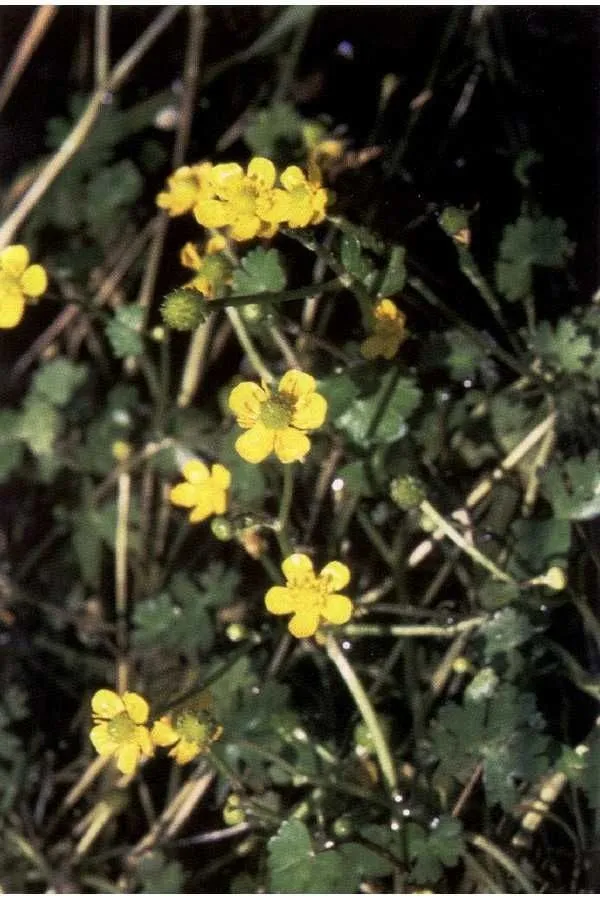
Author: DC.
Bibliography: Syst. Nat. 1: 303 (1817)
Year: 1817
Status: accepted
Rank: species
Genus: Ranunculus
Vegetable: False
Observations: Subarctic to N. & WC. U.S.A.
Gmelin’s buttercup, known scientifically as Ranunculus gmelinii, is an intriguing member of the Ranunculaceae family. First described by the botanist Augustin Pyramus de Candolle in 1817, this plant has garnered attention for both its resilience and its vibrant, appealing appearance.
Native to subarctic regions and extending its presence to sectors of the northern and west-central United States, Gmelin’s buttercup thrives in cooler climates. The natural habitats of this plant often include wet meadows, riverbanks, and other moist environments where it can absorb ample water to support its growth.
The plant is characterized by its distinctive bright yellow flowers, which typically bloom from late spring to early summer. These flowers are composed of five petals that form a cup-like shape, a typical characteristic of the buttercup genus. The central part of the flower is marked by numerous stamens and pistils, contributing to its reproductive success.
Gmelin’s buttercup is not just visually pleasing but also ecologically important. It plays a role in local ecosystems by providing nectar and pollen for various pollinators, including bees and butterflies. Despite its seemingly delicate structure, the plant exhibits a robust nature, thriving in some of the harsher, more variable climates of its range.
In addition to its ecological role, Gmelin’s buttercup has also found its way into horticultural practices, particularly among enthusiasts of native plants. Its aesthetic appeal and adaptability make it a desirable choice for gardens aiming to foster local flora and fauna.
Understanding and appreciating plants like Gmelin’s buttercup is essential not only for their beauty but for their contributions to biodiversity and ecosystem stability. This vibrant species exemplifies the intricate balance of nature and the enduring charm of wildflowers.
Eng: gmelin’s buttercup, lesser yellow water buttercup, small yellow water buttercup, gmelin’s water buttercup, gmelin’s water crowfoot, small yellow water crowfoot
Fra: renoncule de gmelin
En: Gmelin’s buttercup, Lesser Yellow Water Buttercup, BUTTERCUP, Small yellow water buttercup, Gmelin’s water buttercup, Gmelin’s water crowfoot, Small yellow water crowfoot
Zh: 小掌叶毛茛
Fr: Renoncule de Gmelin
Ru: Лютик Гмелина
© copyright of the Board of Trustees of the Royal Botanic Gardens, Kew.
© copyright of the Board of Trustees of the Royal Botanic Gardens, Kew.
Taken Jun 28, 2022 by Sarah Hart (cc-by-sa)
Taken Jan 1, 1900 by EOL − USDA NRCS Wetland Science Institute. (public)
Taken Jul 6, 2013 by EOL − Mary Winter (public)
Growth habit>: Forb/herb
Family: Myrtaceae Author: (F.Muell.) K.D.Hill & L.A.S.Johnson Bibliography: Telopea 6: 402 (1995) Year: 1995 Status:…
Family: Rubiaceae Author: Pierre ex A.Froehner Bibliography: Notizbl. Bot. Gart. Berlin-Dahlem 1: 237 (1897) Year:…
Family: Sapindaceae Author: Koidz. Bibliography: J. Coll. Sci. Imp. Univ. Tokyo 32(1): 38 (1911) Year:…
Family: Asteraceae Author: A.Gray Bibliography: Pacif. Railr. Rep.: 107 (1857) Year: 1857 Status: accepted Rank:…
Family: Fabaceae Author: Medik. Bibliography: Vorles. Churpfälz. Phys.-Ökon. Ges. 2: 398 (1787) Year: 1787 Status:…
Family: Aspleniaceae Author: (Cav.) Alston Bibliography: Bull. Misc. Inform. Kew 1932: 309 (1932) Year: 1932…